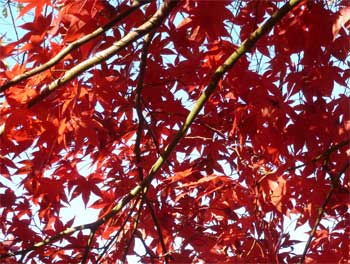When it comes to living in upstate New York, people find a lot to complain about: the taxes are too high, it's so cold here in winter, it too hot and humid each summer, we get a heck of a lot of snow. Blah, blah, blah. Drive along a colorful stretch of highway in the fall, and all the griping recedes into the back of the mind. Autumn in New York--in all its yellow, gold, red, burgundy and orange-leafed glory--is a sight to behold. This year has been especially gorgeous, because by early November, the leaves are still brilliantly holding court. In some spots near New York City, the trees are just hitting their stride. Why is this? To fully understand it, let's take a quick refresher on the leaf cycle.
As we all know, leaves change color when chlorophyll production--necessary for making leaves green--halts. As summer ends, the days get shorter, and nights get colder, signaling trees to begin getting ready for winter. During winter, there isn't enough light or water for photosynthesis, so trees take a break, and live off the food they made in the leaves, and stored during the summer.

As the bright green fades away, orange and yellow hues emerge. What's incredible --and often not realized--is that small amounts of these colors have been in the leaves all along. We just can't see them in the summer, because they're covered up by the green chlorophyll.
The bright reds and purples we see, on the other hand, are made mostly in the fall. In some trees, like maples, glucose is trapped in the leaves after photosynthesis stops. Sunlight and the cool nights of autumn cause the leaves to turn this glucose into reddish, purple and burgundy hues.
The brown color of trees like oaks is not due to any defect in the trees (no, your oaks aren't diseased or dying). It's created from wastes left in the leaves.
Why does the foliage seem to have hung on for so much longer this year? It's not our collective imaginations--leaf-peeping season has been delightfully extended due to a few key factors: a dry summer, and warmer-than-usual fall.
Fall foliage is most vibrant when summer is moderately wet, autumn days are warm, and fall nights are crisp and cold. This year, the northeast had drought during the height of the summer season, so leaves actually started changing earlier, but because the days have been unseasonably warm, and the nights not quite as cold, leaves aren't getting the message to completely cut off chlorophyll production. The result: it takes longer for leaves to reach the colorful change--hence, the lingering hues, and extended "rake time" for us all. The tradeoff: the leaves aren't quite as bright as in year's past.
I tested this theory in my own backyard, and documented the results. Most seasons, my backyard trees have all leafed out by late October, and have begun the shedding process just as my Japanese maple begins its glorious transformation. This year, the Japanese maple changed color right alongside the other trees (top photo), and the effect was a magical potpourri of hues ranging from palest yellow to deepest burgundy. A sight to be seen!!

No comments:
Post a Comment